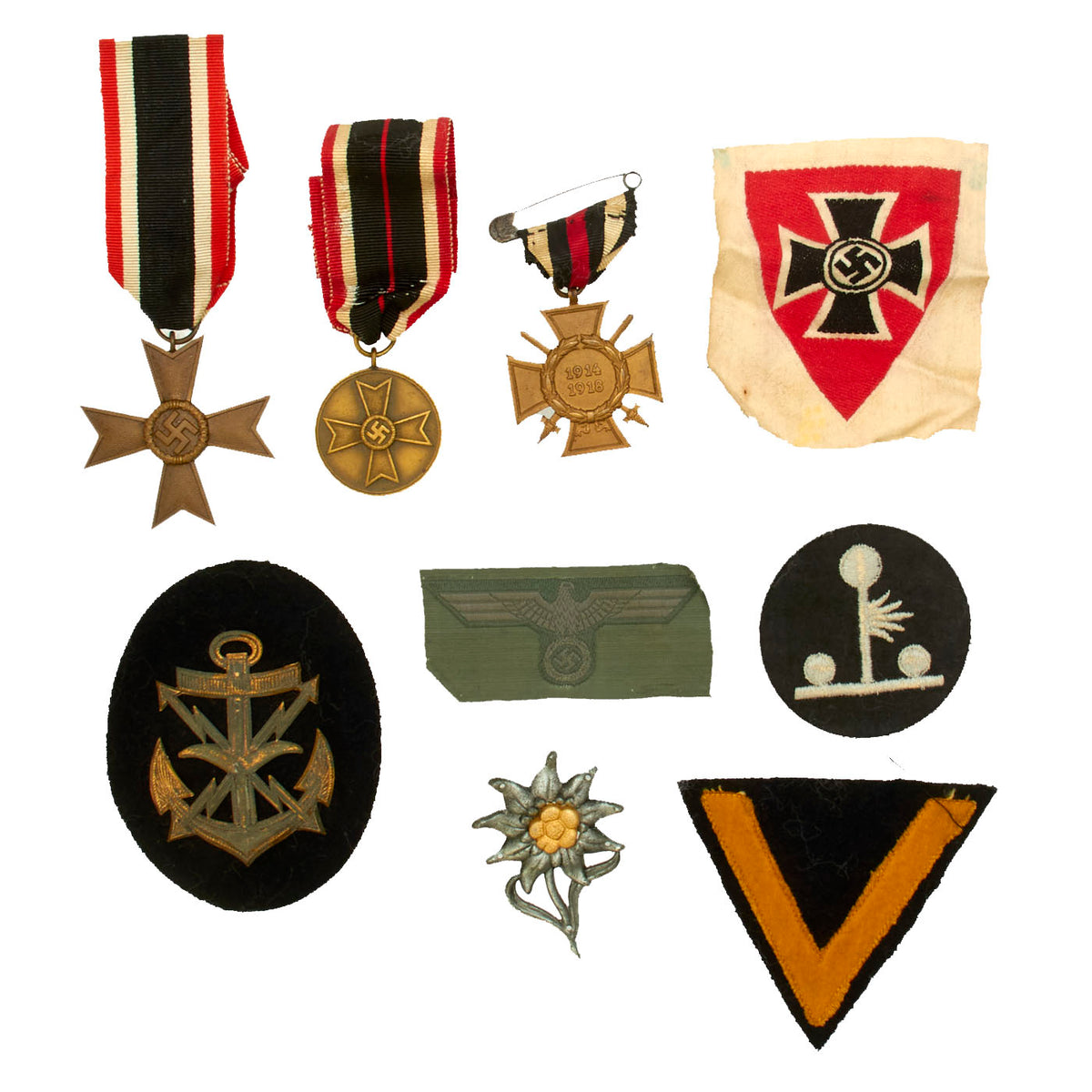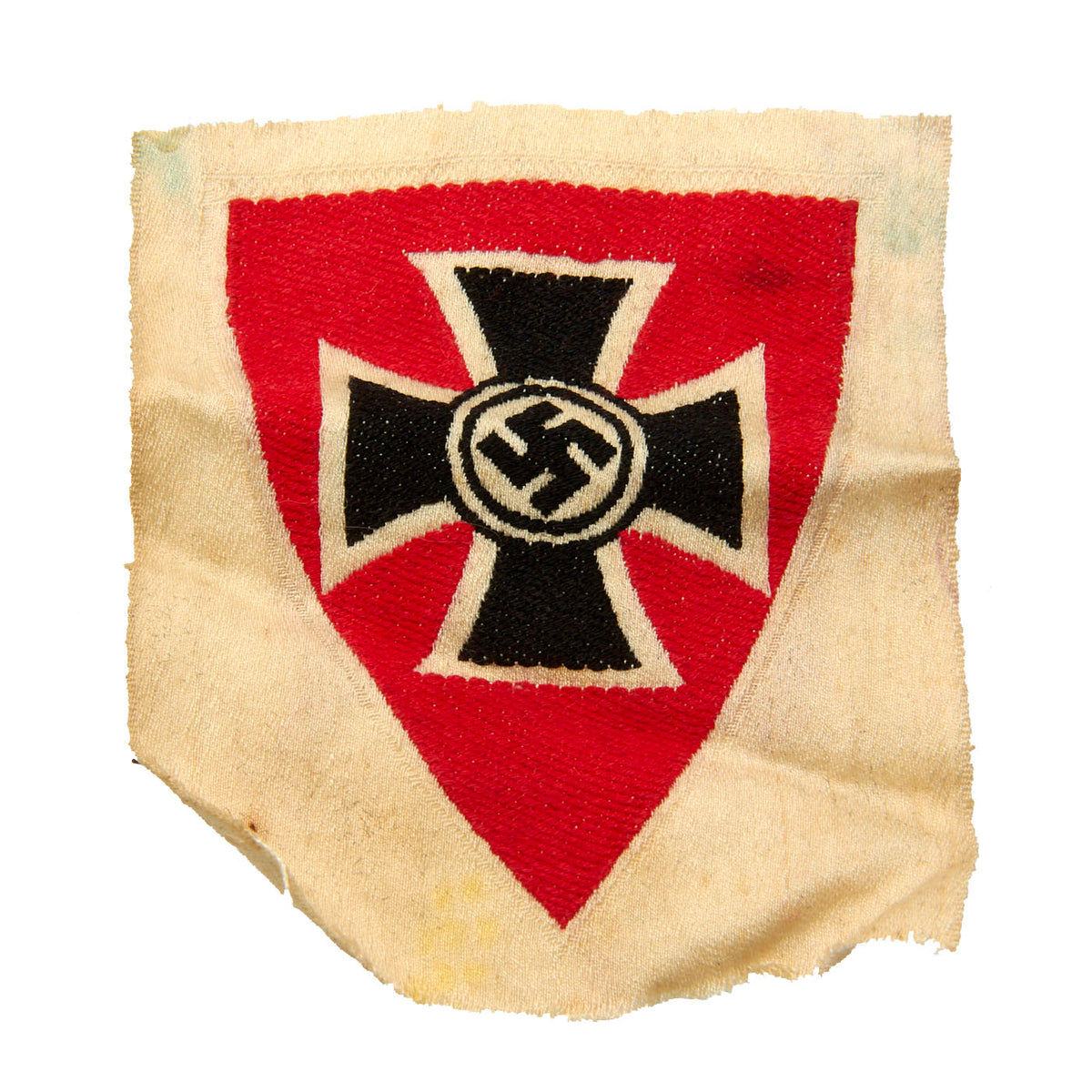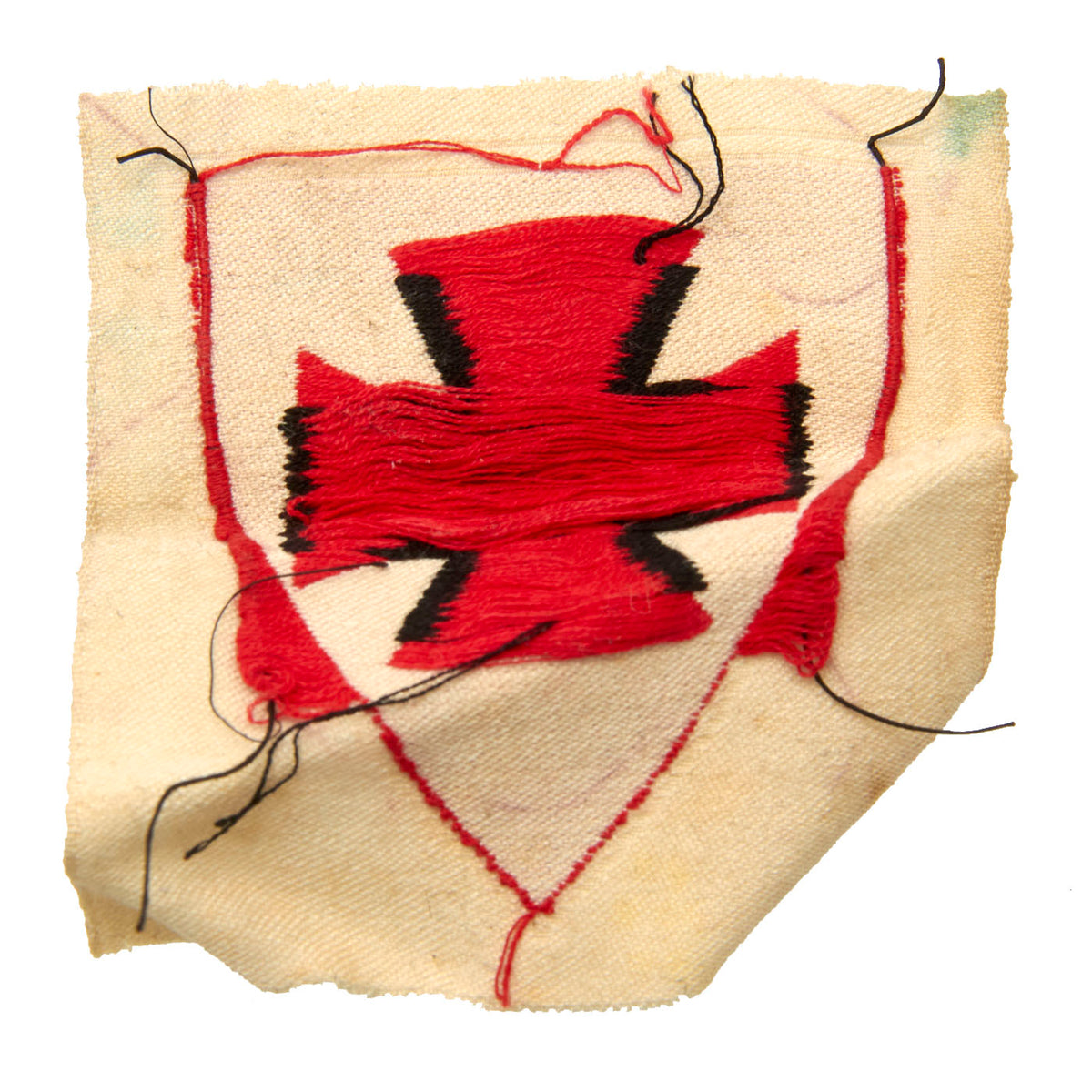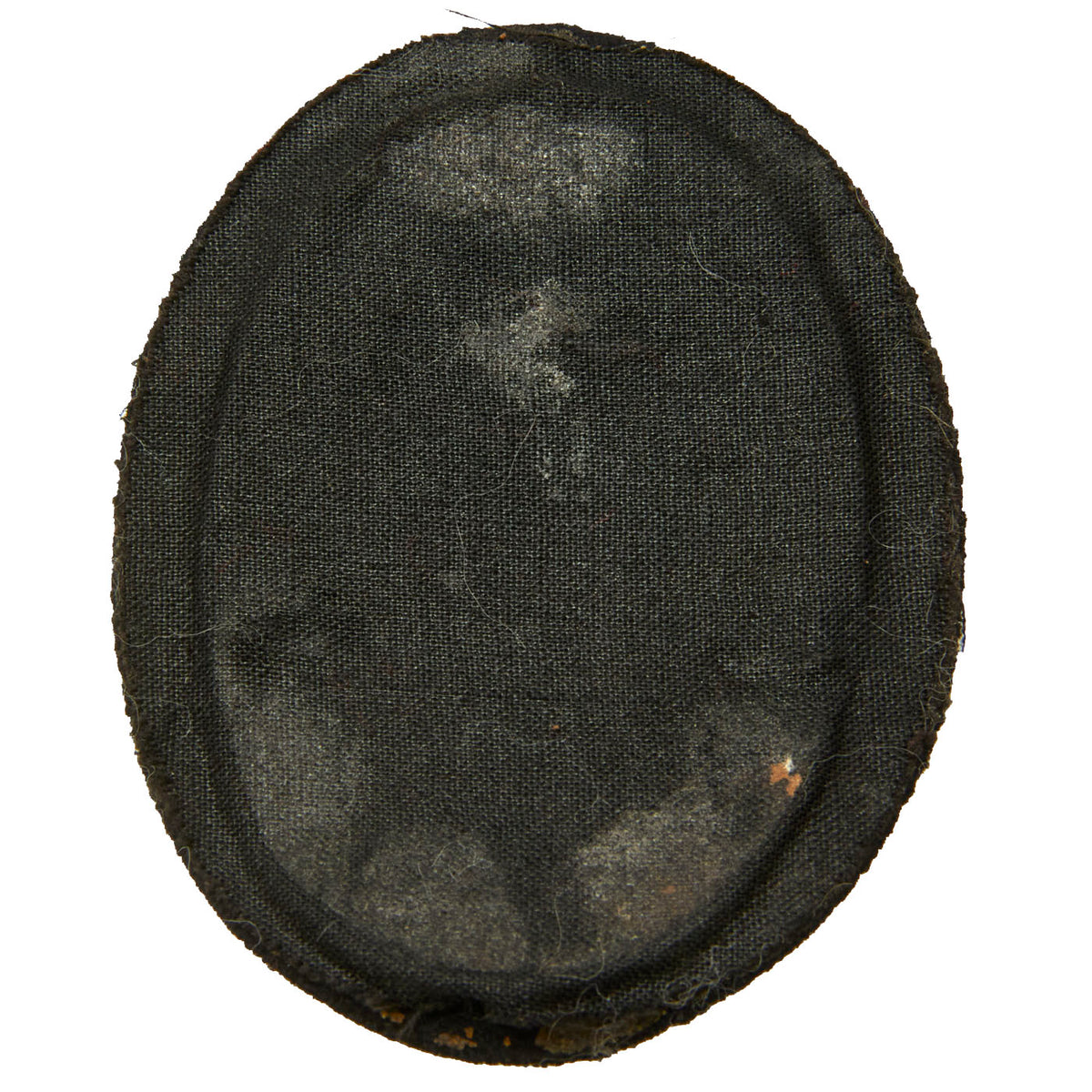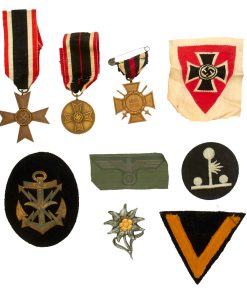Original German WWII Era Medal and Insignia Grouping with Hindenberg Cross & KvKII – 9 Items Original Items
$ 195,00 $ 78,00
Original Items: Only One Set Available. This is a very nice collection of German WWI & WWII Insignia & Awards, which was brought back from the European theater by a USGI after the war was concluded. It includes some a wide variety of medals and insignia, including a Hindenberg Cross, a WWII War Merit Cross 2nd Class, and more!
This lovely set includes:
– One German WWII War Merit Cross 2nd Class – without swords. It is attached to the correct ribbon, and has a lovely patina.
– One Pre-WWII German WWI Honor Cross of the World War 1914/1918 (Hindenburg Cross) Medal attached to a short ribbon with a safety pin.
– One German WWII 1939 War Merit Medal (Kriegsverdienstmedaille), with original ribbon.
– One German WWII Heer Gebirgsjäger Mountain Trooper Metal Cap Badge – Edelweiß.
– One Original German WWII BeVo Green & Gray Cap Eagle – Wehrmachtadler.
– One Original German WWII National Socialist State Veteran’s Association BeVo Insignia – NSRKB.
– One Original German WWII Luftwaffe Air Force Mannschaften (Enlisted Man) Searchlight Equipment Administration Specialist Badge.
– One German WWII Kriegsmarine Navy Mannschaften (Enlisted Man) Aircraft Spotter Trade / Corps Badge – metal on felt backing.
– One German WWII Kriegsmarine Navy Mannschaften (Enlisted Man) Single Gold-Yellow Chevron badge. (Seaman 2nd class).
A wonderful totally genuine grouping perfect for the German Medal and Insignia collector.
War Merit Cross 2nd Class (Kriegsverdienstkreuz) – without swords
This was a decoration of NSDAP Germany during the Second World War, which could be awarded to military personnel and civilians alike. By the end of the war it was issued in four degrees, and had a related civil decoration. It was created by Adolf AH in October 1939 as a successor to the non-combatant Iron Cross which was used in earlier wars. The award was graded the same as the Iron Cross: War Merit Cross Second Class, War Merit Cross First Class, and Knights Cross of the War Merit Cross. The award had two variants: with swords given to soldiers for exceptional service “not in direct connection with combat”, and without swords for meritorious service to civilians in “furtherance of the war effort”. As with the Iron Cross, Recipients had to have the lower grade of the award before getting the next level.
Hindenburg Cross with Crossed Swords (for combat):
The Honor Cross of the World War 1914/1918 (German: Das Ehrenkreuz des Weltkriegs 1914/1918), commonly, but incorrectly, known as the Hindenburg Cross was established by Field Marshal Paul von Hindenburg, President of the German Republic, by an order dated 13 July 1934, to commemorate the distinguished deeds of the German people during the First World War. This was Germany’s first official service medal for soldiers of Imperial Germany who had taken part in the war, and where they had since died it was also awarded to their surviving next-of-kin. Shortly after its issuance, the government of NSDAP Germany declared the award as the only official service decoration of the First World War and further forbid the continued wearing of German Free Corps awards on any military or paramilitary uniform of a state or NSDAP Party organization.
This example is marked on the back with L. / NBG.
The War Merit Medal (Kriegsverdienstmedaille) was a World War II German military decoration awarded to recognize outstanding service by civilians in relation to the war effort. It was instituted on 19 August 1940 and usually awarded to those workers in factories who significantly exceeded work quotas. The War Merit Medal was awarded only to Germans and non-Germans civilians, to men and women. An estimated 4.9 million medals were awarded by the end of the war in Europe. It was closely related to the War Merit Cross, which could be awarded to military personnel and civilians alike for outstanding service to the war effort.
The medal was designed by Professor Richard Klein of Munich. It was a circular bronze award bearing the design of the War Merit Cross on the front (obverse), and the inscription “For War Merit 1939” (Für Kriegsverdienst) on the reverse side. It was suspended from a ribbon colored similar to the War Merit Cross, except for a thin red vertical strip added to the center of the black portion. When worn, it was either as a medal ribbon bar above the left breast pocket (soldiers who had earned the medal as civilians could wear it on their uniform), or with the ribbon only through the second buttonhole of a jacket. Since this was a non-combat award, the medal never incorporated swords. After 15 May, 1943, the award of this medal to foreigners was superseded by the Medal of Merit of the Order of the German Eagle.
Fast Shipping with Professional Packaging
Thanks to our longstanding association with UPS FedEx DHL, and other major international carriers, we are able to provide a range of shipping options. Our warehouse staff is expertly trained and will wrap your products according to our exact and precise specifications. Prior to shipping, your goods will be thoroughly examined and securely secured. We ship to thousands clients each day across multiple countries. This shows how we're dedicated to be the largest retailer on the internet. Warehouses and distribution centres can be located throughout Europe as well as the USA.
Note: Orders with more than one item will be assigned a processing date depending on the item.
Before shipping before shipping, we'll conduct a thorough inspection of the items you have ordered. Today, the majority of orders will be delivered within 48 hours. The delivery time will be between 3-7 days.
Returns
The stock is dynamic and we cannot completely manage it because multiple stakeholders are involved, including our factory and warehouse. So the actual stock may alter at any time. It's possible that you may not receive your order once the order has been made.
Our policy is valid for a period of 30 days. If you don't receive the product within 30 days, we are not able to issue a refund or an exchange.
You can only return an item if it is unused and in the same state as the day you received it. You must have the item in its original packaging.
Related products
Uncategorized
Uncategorized
Uncategorized
Band of Brothers ORIGINAL GERMAN WWII Le. F.H. 18 10.5cm ARTILLERY PIECE Original Items
Uncategorized
Uncategorized
Uncategorized
Uncategorized
Uncategorized
Uncategorized
Uncategorized
Armored Burgonet Helmet & Polearm from Scottish Castle Leith Hall Circa 1700 Original Items
Uncategorized
Uncategorized
Uncategorized
Uncategorized
Uncategorized
